Row after row of sleek black telephones on white plinths, each one indistinguishable from the next; we are reminded at first of the cold, impersonal, mass-produced objects of a factory, devoid of human traces. When we bring the receiver to our ear, however, we hear a single human voice on the other end. She speaks in cool, clear Mandarin, her tone introspective, distant, as though recounting a dream: ‘Tomorrow you will see only birds on the square.’[1] We trace this disembodied voice from telephone to telephone and soon realize the temporal gap between us— ‘At the end of the century we have become temporary actors,’ she says, ‘We’ve shed old values and are reluctant to take on new ones.’ The messages are impressionistic fragments, overlapping and contradictory. She is self-disparaging—’Our past is really too unworthy to mention’—then self-assured—’We are running in reality, tracing lines, fixing patterns.’ Sometimes we pick up the receiver to hear music achingly familiar to anyone who lived in China in the 1990s. Like the mysterious female voice, these songs express a certain conflictedness about moving on, an inability to shed the past. ‘Let it come lightly, let it depart well,’ pop singer Tsai Chin croons, before returning to the well-known chorus: ‘Year after year I cannot stop remembering, remembering you, remembering our past.’[2]
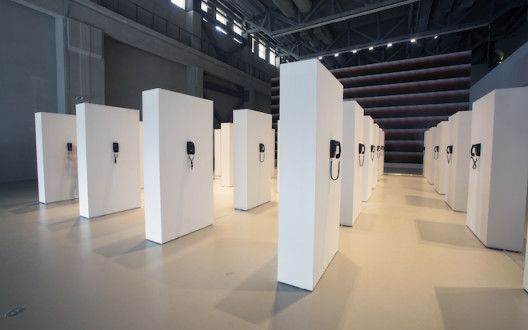

“1999,” an evocative and haunting work at the recent Shanghai Biennale, is a sound installation by artist Liu Ding in which an episodic narrative of cultural life in 1990s China unfolds through a series of so-called ‘telephone calls from the past.’ The work captures the decade’s profound ambivalence, caught between hopes for a faster, wealthier, more modernized future and anxiety about the disintegration of the past—a fear born of a tumultuous century and perpetuated by the aggressive demolition campaigns of the post-Mao government, which razed historic sites in the name of economic progress. And, of course, the traumatic silence over the events of June fourth, 1989 further deepened the rift between past and future.
Like many of Liu Ding’s artworks, “1999″ is marked by a preoccupation with cultural remembrance. Driven by profound consciousness of the collective amnesia prevalent in contemporary Chinese society, Liu’s works often attempt to dismantle both state propaganda and facile, market-driven narratives of Chinese history through a kind of diligent historicization. Through a return to their original objects, forms, figures, gestures, sounds and sentiments, Liu seeks to revitalize and re-examine historical moments that have been forgotten, sterilized or sensationalized. The shock of the detail and sense of reality brought on by historical specificity is meant to conjure the historical moment in its full intensity and complexity.
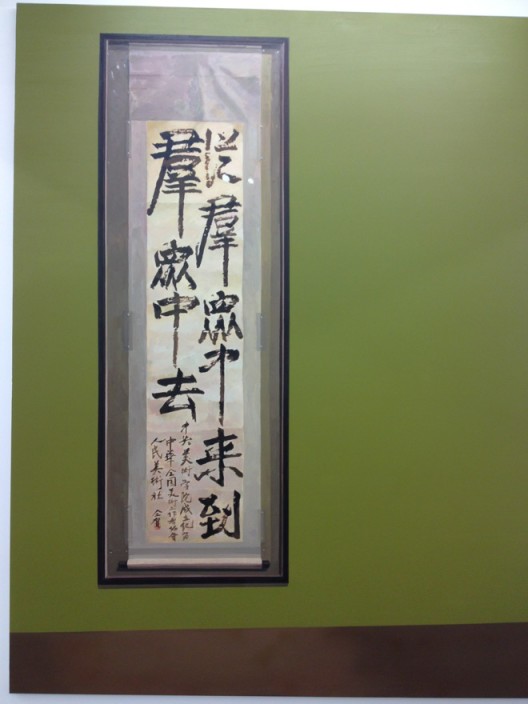
Historicism, however, is hardly a failsafe strategy for remembrance. As Siegfried Kracauer makes chillingly clear in his 1927 essay on photography, the attempt to preserve the past through objective documentation is a futile endeavor; affective experience slips through the cracks of factual description. In his practice, Liu Ding oscillates between art as memory and art as archive. While the details preserved in memory are laden with symbolic and sentimental significance, the undiscerning details of an archive are cold and meaningless. While “1999″ mirrors subjective memory in its remote, oblique and fragmentary form, the works of “New Man,” Liu’s recent solo show at MOT International in London, embody a kind of virtual museum which does not so much resuscitate memory as make visible the state of amnesia itself.
In the title painting of “New Man,” a wealthy art collector appears to be driving a shiny red Ferrari past a painting from the Mao era. The Mao-era painting is a well-known work of Socialist Realism that depicts a ‘hero of labor’ wearing a Red Army uniform—here meticulously recreated in Liu Ding’s own painting. Of course there is the conspicuous contrast between the lifestyle of the art collector and that of the Mao-era worker. Perhaps more disquieting, however, is the setting in which this odd juxtaposition occurs. The inner space of the painting gives no indication of any specific time or place, and though images of past and present technically co-exist here, there is no visible connection or pathway between them. All we see is a generic green background, which, given the framed painting that hangs on it, could be the wall of a museum or gallery, though this does not explain the art collector and his car in the foreground—unless that too is an artwork, a part of the exhibition?
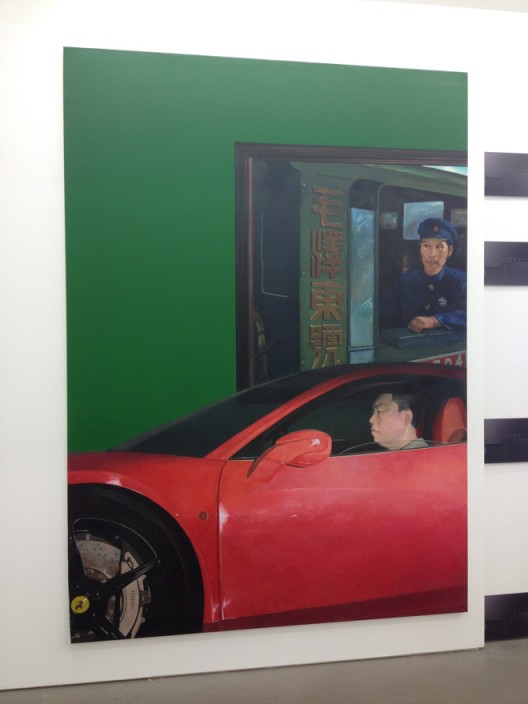
More artworks are replicated and displayed in the painting “Do Something Now.” The seven smaller paintings within this painting are works by the No Name Group[3], a group of painters who secretly experimented with non-Socialist Realist styles during a repressive period of the Cultural Revolution. The group’s significance lies more in their political transgression than in their aesthetic achievement; to the contemporary viewer unfamiliar with their political context, the works may appear unremarkable and derivative of European modernism. Especially given the ahistorical virtual space in which they are displayed, the painted reproductions of “Do Something Now” illuminate neither the harrowing struggle against totalitarian control nor the exhilaration of reclaiming individual subjectivity by artistically re-framing the world. Rather, the images hang dumbly—a girl, a tree, a road, abstracted figures, impressionistic fruits—they trigger no burst of recognition, no chain of associations, no recollections.
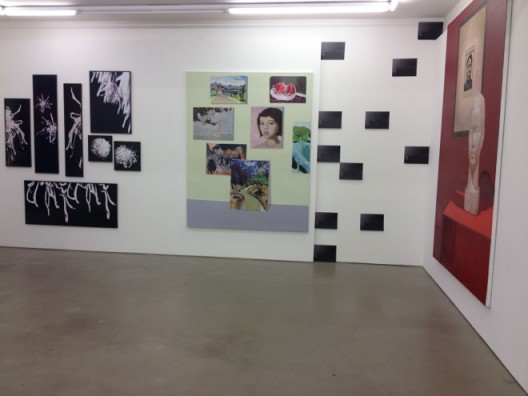
In their formal particularities, the paintings of “New Man” do not so much re-open complex historical moments (such as the Yan’an Talks on Literature and Art and the Cultural Revolution) as they emphasize the impossibility of accessing this past under certain conditions of contemporary existence. In the barely discernible inner space of each painting, pieces of the past float untethered to memory. Indeed, the paintings, with their flat and cropped qualities, seem to have been consciously made to resemble iPhone photos snapped by a tourist passing through a museum—images that serve no other purpose than to prove that the works displayed exist and that whoever took the photo has seen them. As such, they themselves aren’t artworks, but are merely records of artworks.
“1989,” another painting in “New Man,” further confirms this reading. Here we see the year 1989 painted in large letters across an electric blue background. The reference to June Fourth hardly needs decoding, and would in itself be unremarkable except for the light blue bar across the top and the little white “x” in the upper right corner, which reveal the painting’s surfaces to be that of a browser window and a computer screen. This could be a reference to the community of politically engaged “netizens” in China, though there are no celebratory overtones here, no hint of the democratizing tendencies of the internet. Rather, more immediately and intensely, the painting evokes a sense of alienation and rootlessness—we are now living in a time in which historical memory has been reduced to the flat and unreal browser window; the past can be made to disappear with one click.
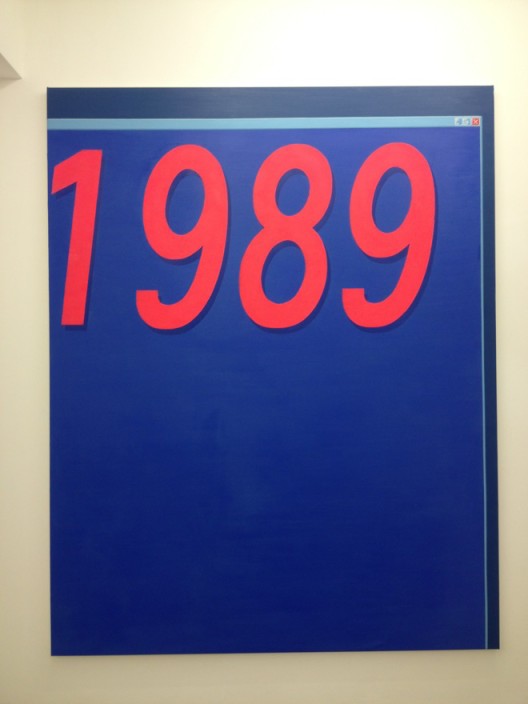
The evocation of amnesia intensifies in the video installation “Karl Marx in 2013,” which documents a Chinese tour group’s visit to Karl Marx’s grave in Highgate Cemetery in London. The visit is uneventful, and feels more like a banal excursion than a pilgrimage to the final resting place of the most influential Western thinker in modern Chinese history. We see shots of the otherwise deserted park—empty roads, tombs overgrown with moss and leaves, still ponds and trees, loitering pigeons. When the tourists finally arrive at Marx’s tombstone, many immediately launch into a ceaseless stream of photo-taking, while others don’t look at all but rather turn away to speak on cell phones. The collection of photographic stills that accompanies the video drives home the utter disconnect between memory and visual documentation. There are about thirty photographs, all crammed into one frame. Again we see the empty roads, the grass, the trees, the tombstones covered with moss. And yet there is no way to really look. The more images there are, the less is seen and remembered.
Whereas in “1999,” we are beckoned to retrieve the substance of the past from within mass-produced, industrial exteriors, in “New Man,” we are confronted with only exteriors and surfaces—there is nothing to retrieve. While “1999″ penetrates the dead, ossified exteriors of history to carve out a fresh pathway between past and present, the artworks of “New Man” function as a kind of virtual archive which, consciously or unconsciously, reveals the impotence of the contemporary virtual archive itself. The intimacy and particularity of the telephone call is here replaced with the frivolity and banality of the Instagram photo. These works, in highlighting the inaccessibility of the past in our society of virtual spectacles, bring to mind Jonathan Crary’s words in “24/7″:
Amid the mass amnesia sustained by the culture of global capitalism, images have become one of the many depleted and disposable elements that, in their intrinsic archiveability, end up never being discarded, contributing to an ever more congealed and futureless present.[4]
With each image in “New Man,” we are reminded of our fractured attention and our increasing incapacity for sustained recollection. The past is only accessible through the touchscreen, and the world is a stream of instantaneous and empty images, into whose depthlessness memories disappear.
In his theoretical writings as well as his artworks, Liu Ding has urged for a deeper relationship with the past—not as a dead, external form to be cast off, but rather as a vital source of existential meaning for the present—something of which we must constantly renew our consciousness and understanding.[5] However, his works also reveal the substance of the past to be an elusive thing which can’t always be trapped in the net of meticulous historical documentation. Whether it mirrors memory, archive, or other forms in which the past may appear, Liu Ding’s art in any case serves as a useful reminder of the urgency of our own task as contemporary rememberers, as China—and the late-capitalist world—continues its march into a future seemingly without a past.
(From May 1 to August 20, Liu Ding will participate in the group show “From a Poem to the Sunset” at Daimler Art Collection in Berlin. He will also take part in the Istanbul Biennial in September.)
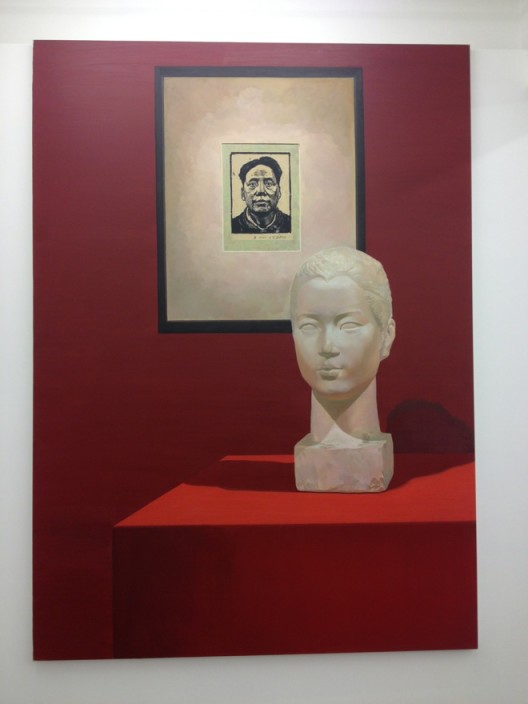
[1] Translation of audio excerpts from this work are by the author.
[2] Lyrics from the song ‘Just Like Your Tenderness’ (恰似你的温柔 ‘Qia si ni de wen rou’), translation by the author. Original lyrics: 让它淡淡的来,让他好好的去, 到如今年复一年,我不能停止怀念,怀念你,怀念从前.
[3] This information is taken from the catalogue essay provided by MOT International gallery: “New Man: Liu Ding’s Approach and Situation” (新人:刘鼎的路径与处境) by Luan Zichao (栾志超), translated into English by Sarah S.Y. Lee.
[4] Jonathan Crary, 24/7: Late Capitalism and the Ends of Sleep, Verso, New York: 2014, 34-5. This remark is taken from Crary’s discussion of Jean-Luc Godard’s In Praise of Love (2001).
[5] In an essay by Lu Ding co-written with Carol Yinghua Lu, “From the Issue of Art to the Issue of Positions:The Echoes of Socialist Realism,” Liu Ding calls for a re-examination of Socialist Realism and recognition of its embeddedness in the inner logic of contemporary Chinese art and cultural psyche.